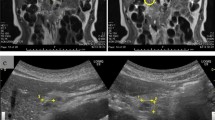Abstract
A 75-year-old man was diagnosed as having a sessile tumor measuring 1.4 x 1.0 cm in size in the duodenal bulb after upper gastroduodenal series. The biopsy specimens revealed a proliferation of the adenomatous glands showing an acinar structure with papillary infolding; type III mucus, which is characteristic of Brunner’s glands. Antral glands and mucus neck cells of the fundic glands were also observed in the adenomatous glands by concanavalin A staining. Thus, it was clear that the tumor had originated from the Brunner’s glands. Three years and four months later, the sessile tumor had developed into a fungating ulcerated tumor via a polypoid form. The biopsy specimens revealed a papillary adenocarcinoma with foci of undifferentiated carcinoma. Retrospectively, the adenomatous glands in the biopsy taken from the sessile tumor should have been regarded as low grade carcinoma. Therefore, we propose that when a polyp or tumor shows an increase in size or change in macroscopic appearance, surgery should be considered.
Similar content being viewed by others
References
Stewart HL, Lieber MM. Carcinoma of the suprapapillary portion of the duodenum. Arch Surg 1937;35:99–129F.
Dixon CF, Lichtman AL, Weber HM, Mcdonald JR. Malignant lesions of the duodenum. Surgery Gynec Obstet 1946;83:83–93.
Christie AC. Duodenal carcinoma with neoplastic transformation of the underlying Brunner’s glands. Br J Cancer 1952;7:65–67.
Shorrock K, Haldane JS, Kersham MJ, et al. Obstructive jaundice secondary to carcinoma arising in Brunner’s glands. Jr Soc Med 1986;79:173–174.
Miyamoto T, Matsuba S, Yokohama Y, et al. Early duodenal cancer supposedly arising from the Brunner’s gland, report of case. Stomach and Intestine 1991;26:1395–1399. (in Japanese)
Iovine VM, Tsagaris N. Primary carcinoma of the duodenum. Am. Surg 1961;27:744–750.
Lillemoe K, Imbembo AL. Malignant neoplasms of the duodenum. Surg Gynecol Obstet 1980;150:822–826.
Leesson TS, Leesson CR. The fine structure of Brunner’s glands in man. J Anat 1968;103:263–276.
Katsuyama T, Spicer SS. Histochemical differentiation of complex carbohydrates with variants of the concanavalin A-horseradish peroxidase method. J Histochem Cytochem 1978;26:233–250.
Muto T, Bussey HJR, Morson BC. The evolution of cancer of the colon and rectum. Cancer 1975;36:2251–2270.
Wellin S, Youker J, Spratt JS. The rates and patterns of growth of 375 tumors of the large intestine and rectum observed serially by double contrast enema study (Malmo tecnique). Am J Roentgenol 1963;90:673–687.
Ekelund G, Lindström C, Rosengren JE. Appearance and growth of early carcinomas of the colon-rectum. Acta Radiol 1974; 15:670–679.
Author information
Authors and Affiliations
Rights and permissions
About this article
Cite this article
Itsuno, M., Makiyama, K., Omagari, K. et al. Carcinoma of duodenal bulb arising from the Brunner’s gland. Gastroenterol Jpn 28, 118–125 (1993). https://doi.org/10.1007/BF02775012
Received:
Accepted:
Issue Date:
DOI: https://doi.org/10.1007/BF02775012




